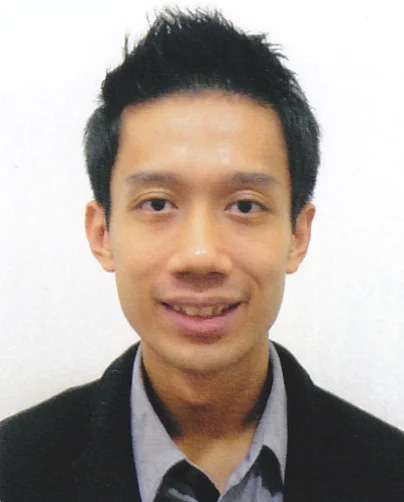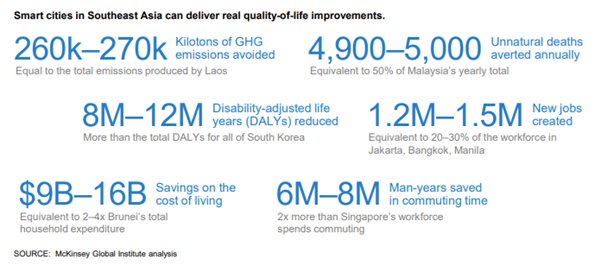

Covid-19 pandemic has severely disrupted lives and economies across the globe. It has also spurred governments to seek out new technological tools and urban solutions that can address the current crisis as well as drive the next stage of economic growth.
A common response among many governments across the world to the Covid-19 pandemic is to hasten the development of their smart cities, exploring ways in which smart city technologies can be applied to crisis management and economic development.
There are a lot of benefits to the establishment of smart cities. According to a report by McKinsey Global Institute, smart cities are expected to create 1.2 million to 1.5 million new jobs and prevent 260,000 to 270,000 kilotons of greenhouse gas emissions. It will also lead to US$9 billion to US$16 billion worth of savings on the cost of living across Asean.
By addressing these urgent economic and environmental challenges, digital services and technologies can help future-proof smart cities against future crises and challenges.
The Covid-19 pandemic has, in fact, laid bare the importance of smart cities, with the digital technologies that have facilitated telecommuting and global financial transactions proving to be crucial in the continued functioning of many urban economies.
Asean Smart Cities Network
In Southeast Asia, smart cities will play an increasingly important role in generating economic growth and solving complex urban challenges. Faced with rapid urbanisation, Southeast Asia is expected to see around 100 million people migrate from rural regions to cities. This is complicated by rapid population ageing in countries such as Singapore and Thailand as well as the emergence of a middle class in other countries, such as Vietnam and Myanmar.
Despite the diversity of their populations and their different stages of economic development, Asean member states are increasingly united by their belief that smart cities may hold the key to the urban and socio-economic challenges that they face.
Governments across Southeast Asia are driving digital transformations in their cities and industries, as seen from Malaysia's National Policy on Industry 4.0 to other nationwide initiatives like the Thailand 4.0 plan. These directions will have a significant impact on economic development and even crisis mitigation across the region.
During the recent 36th Asean Summit, Singapore's Prime Minister Lee Hsien Loong argued that Asean can "use the Asean Smart Cities Network to exchange ideas and experiences on using technology to fight Covid-19. For example, technology to enhance contact tracing".
Established on April 28, 2018, the Asean Smart Cities Network (ASCN) aims to encourage greater cooperation among the 10 Asean member-states to foster smart and sustainable urban development.
The ASCN will be especially relevant to Malaysia, which has recently revealed plans to develop its next smart city project in Johor. As a major Asean economy, Malaysia is well-poised to benefit from its smart cities.
Driving Technological Innovation
At the very heart of any smart city is its urban and technological infrastructure. This includes hardware components such as sensors, cameras and smart grids as well as software elements such as data analytics, artificial intelligence and a smart city "dashboard".
While the embedding of sensors and smart grids in the urban infrastructure will allow governments to continuously collect data to design and run more efficient cities, cutting-edge software will allow for the rapid analysis of data, allowing both governments and businesses to gain a better understanding of citizen and consumer preferences.
With 110 years of experience in operational technology and 60 years of experience in the information technology industry, Hitachi has developed an extensive network of global partners that is focused on co-developing technological solutions to address emerging economic and societal needs.
In Malaysia, through the use of solutions that promote energy conservation, Hitachi is working to address the environmental issues and energy needs that have arisen with smart city developments. Smart cities can indirectly contribute to greater energy consumption levels due to additional power and energy needed for the Internet of Things (IoT) infrastructure.
Hitachi is therefore working with customers and partners to co-create new ways of optimising energy use and consumption. For instance, Hitachi is in a relationship of collaborative creation with Sunway Group to provide energy management systems and technologies to Sunway City.
Developed by Hitachi, the Energy Saving Navigation System (ES-Navi) allows an air conditioning system to adjust the level of cooling required in a building according to changes in the ambient weather, occupancy rate and level of human activity. The system is proposed to be used in Sunway City.
Using the ES-Navi, the air conditioning system (a water-cooled chiller system) will be monitored hourly and optimisation calculated automatically. Recommended optimisation strategies are then sent out to operators, who can then implement revised temperature targets quickly. This leads to better efficiency as it allows for real-time optimisation of energy use and cooling load needs in the building.
As the ES-Navi extracts data from the existing monitoring system and exports them to the cloud, operators have the freedom to access the daily, weekly, monthly or even yearly energy consumption of any buildings using internet browsers anytime, anywhere. This is especially useful for operators who own or manage large townships that house various different buildings like offices and residential areas, shopping centres as well as theme parks. Operators can design daily operations to achieve the most effective energy saving without the need to invest in a new building management or monitoring system.
By working with Sunway City to develop innovative energy management systems, Hitachi is exploring new collaborative business models to co-develop smart urban solutions with its local partners.
Gaining a deeper understanding of the energy and technological needs will help ensure that its solutions and technologies are better targeted at improving the lives of people living and working locally.
Hitachi Social Innovation is POWERING GOOD
A successful smart city should ideally ensure the happiness of its citizens and enhance their quality of life, as well as provide opportunities for personal and community growth that can enhance citizens' social, economic and environmental values. Thankfully, we now possess the technological possibilities for building smart, sustainable and liveable cities of tomorrow.
By focusing on powering good, Hitachi's role in smart city development is very much focused on enhancing and improving the lives of people through Social Innovation. Hitachi seeks to study the real problems faced and solve them via technology, providing effective overall solutions to make lives better and to make the world a better and happier place to live in.
In Asean, Hitachi has been combining IoT, artificial intelligence and data analytics to create smart spaces in cities through collaboration and co-creation with partners.
A smart city is more than its digital and urban infrastructure. Smart city technologies and social innovations can contribute towards the happiness and well-being of citizens. For instance, governments can collect public feedback and data through advanced data analytics platforms and apply these insights to perform more people-centric city planning.
A good example of this is Hitachi's efforts to use data and people-flow analysis to understand human flow within the city to ensure more effective location of public amenities such as parks and childcare centres. This will greatly enhance citizens' quality of life and contribute to greater collective happiness.




